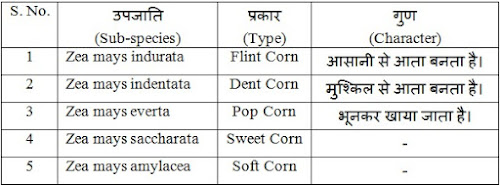Botanical characteristics of Maize
Origin of Maize :-
1. Introduction:-
> Common Name:- Maize, Corn
> Botanical Name:- Zea mays
> Family:- Poaceae or Gramineae
> Maize has the highest crop yield among all of the cereals, hence it is called the 'queen of cereal crops.
2. Chromosome Numbers and Species:-
3. Types of Maize:- 5 types –
4. Center of Origin:-
· Primary Center of Origin:- Mexico
· Secondary Center of Origin:- China
Cultivation of Maize:-
1. Climate requirements:-
> Maize requires the warmth and humid climate.
i. For germination is 21 degree C.
ii. For growth is 32 degree C.
2. Soil type:-
> Maize thrives better on well drained ,sandy- loam to silty – loam soils.
> Land Preparation:-
- Give four to five ploughings and plankings to make the seed–bed free from clods and weeds.
- Use mould board plough ,disc harrow or cultivator for the 1st cultivation.
3. Time of sowing:-
> Last week of May to end of June.
> Seed rate:- Use 7 kg seed for popcorn and 8 kg per acre for other varieties.
4. Improved Varieties:-
i. PMH 11:- It matures in 95 days and its average yield is 22.0 q/acre.
ii. Parbhat:- It yields about 17.5 q/acre.
iii. PMH 1:- It matures in 95 days and average yield is 21 q/acre.
iv. PMH 2:- It matures in about 83 days and its average yield is 18 q/acre.
v. Punjab Sweet Corn 1:- It matures in about 95-100 Days . Its average green ear and grain yield is 50 and 13 q/acre.
5. Weed Management:-
> Culture:- Give two hoeings about 15 to 30 days after sowing with khurpa /kasaula/wheel-hoe etc.
> Chemical:- For control of dila/motha, apply 400ml per acre 2,4-D amines salt 58 SL as post emergence 20-25days after sowing in 150 L of water.
6. Irrigation management:-
> Generally, 4 -6 irrigations are required depending upon rainfall.
> Critical stages for irrigation – Tasseling and Silking.
7. Nutrient management:-
> Hybrid variety:- 120:50:40 NPK kg /ha.
> Composite variety:- 100:40: 30 NPK kg /ha.
> Paddy straw compost @ 180 kg per acre along with recommended dose of fertilizers can be alternate to FYM.
8. Harvesting and Threshing:-
> The maize crop is ready for harvesting even when the stalks and leaves are some what green but the husk cover has dried and turned brown.
> Maize shelled when the moisture content ranges between 15 to 20 %.
Improvement of Maize:-
1. Pollination:-
Ø Pollination in maize is by air.
Ø Maize is mainly a cross pollinated crop. It has 95% cross pollination and 5% self pollination.
Ø The following adaptations are found in maize plant for cross pollination:-
i. Unisexual flowers
ii. Monoecious plant
iii. Difference in maturation times of male and female inflorescence
iv. Silk fibers are receptive throughout their full length
v. Infinite pollen production
Ø Protandry is found in maize. Flowering in tassels takes place 2 days before cob.
Ø Maize shed pollens continuously up to 14 days.
Ø The viability of pollens lasts for 24 hours.
Ø The flowering of the female spikelets begins 2–5 days after the full opening of the tassel.
Ø In maize, the entire style acts as a stigma. The style remains receptive throughout its length for 14 days.
2. Breeding Objectives:-
a. Higher Yield:- It depends on the following factors -
i. Number of cobs per plant
ii. Size of cob
iii. Number of queues per cob
iv. Number of grains per queue
v. Size of grains
b. Adaptation:-
> Maize is a Short Day Plant. That is, for flowering it requires 8 hours of light and 16 hours of darkness.
> Flowering in maize depends on 2 factors -
i. Photoperiod
ii. Temperature
> Therefore, the production of photo-insensitive and early maturation varieties in maize is the purpose of breeding.
c. Quality:-
· Maize seeds contain 10% protein, of which 8% is Prolamin protein called Zein.
· Protein lacks lysine and tryptophen amino acids.
· Seeds also lack vitamin-B3, the deficiency of which causes Pilegra disease.
· The yield has an inverse relationship with the amount of protein. Increasing the amount of protein decreases the yield. The reason for this is that the cost of protein synthesis is high. More photosynthesis is required.
· The yield has a direct relationship with the amount of starch. Increasing the amount of starch increases the yield. The reason for this is that the cost of starch synthesis is low. Less photosynthesis is required.
d. Heat and Drought Resistance:-
· At temperatures above 38 ° C, the viability of pollens decreases.
· The rate of increase in cob length decreases in drought conditions. By the time cob comes out, pollens are over.
· Therefore, temperature resistant and drought resistant varieties should be developed in maize crop.
e. Disease Resistance:- Several types of diseases can occur in the maize crop which can cause economic loss. Developing resistance against these diseases is also objective of plant breeding.
i. Leaf Spot
ii. Leaf Blight
iii. Downy Mildew
iv. Rust
v. Sheath Blight
f. Insect Resistance:- Several types of insect pests can cause damage to the maize crop which leads to economic loss. Hence one objective is to generate resistance against these insect pests.
i. Stem Borer
ii. Cut Worm
iii. Shoot Fly
iv. Leaf Roller
v. Aphids
vi. Grass Hopper
3. Breeding Methods:-
a. Introduction:- Eto Amarillo (From Mexico to India)
b. Variety:- The improved variety 'Vikram' was developed by hybridizing the native variety 'basi' with the introduced variety 'Eto Amarillo'.
c. Double Cross Hybridization:-
- Punjab Hybrid - 1
- Punjab Hybrid - 3
- Ganga - 1
- Ganga - 101
- Deccan
- Ranjit
d. Composite Varieties:-
- Kisan
- Amber
- Jawahar
- Sona
- Vijay
- Proteina
- Ratan
- Shakti
- Vikas
- Navjot
- Dhawal
- Renuka
- NLD

